#built in modules in python
Explore tagged Tumblr posts
Text
why the hell is python basically "the beginner language" its so fucking annoying i wanted to try to do something relatively simple (click when the pixel under my cursor changes color) but i had to spend like 45 minutes getting it to be able to control my mouse and do things such as click because i found the module i need for it and tried to install that only for pip to just not work because apparently you need to either be in regular command prompt and type "py -m" before it or you need this longass command in order to do it through the python console and it took way too long to find someone who mentioned that information necessary to install modules but then it wasnt working in pycharm because apparently the installations are specific to the venv rather than just python and so i had to figure out hwo to open up the console in pycharm and use the longass command to install it there BUT THEN that dindt work because the venv didnt allow installing other software or whatever so i had to go to the cfg file for it and FINALLY was able to install it and use it in pycharm. and then i learned that i have to install another module in order to use the sleep command. sleep. why does this beginner language not have a sleep command by default thats such a basic common mechanic why to i need to install and import time anyway if you actually read through all of my rambling and complaining thank you for that and FUCK python. i am however going to continue using it for this little project (building off of the original purpose) because once the modules are installed it is a very simple language
#i vaguely remember pycharm having some way of installing modules built into it but i thought it would be quicker to just use the pip command#it was not#also i did learn python a long time ago but have completely forgotten all of it#196#rule#python
3 notes
·
View notes
Text
Okay, after disabling a couple modules we aren't using we seem to be good to load up to ~100 kB files in one go through the web interface
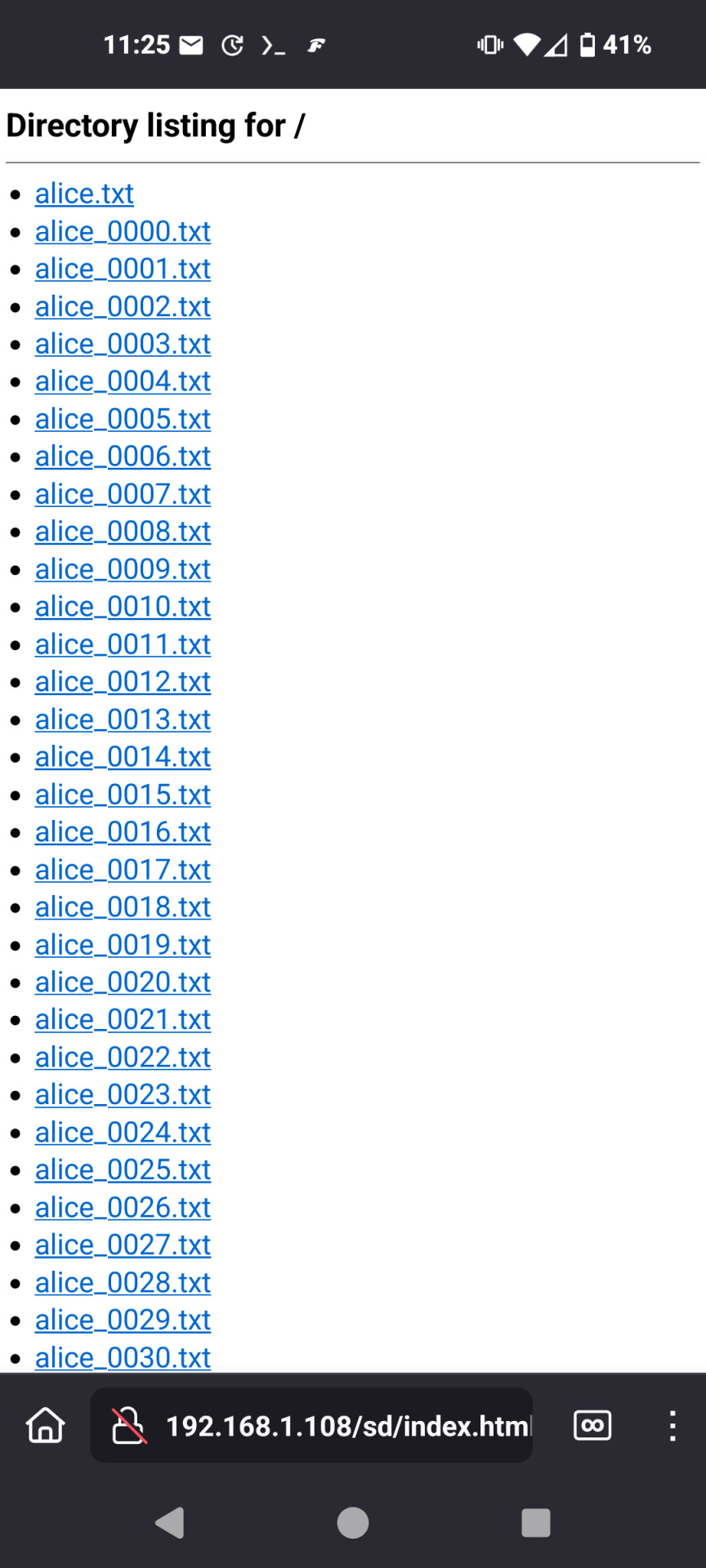
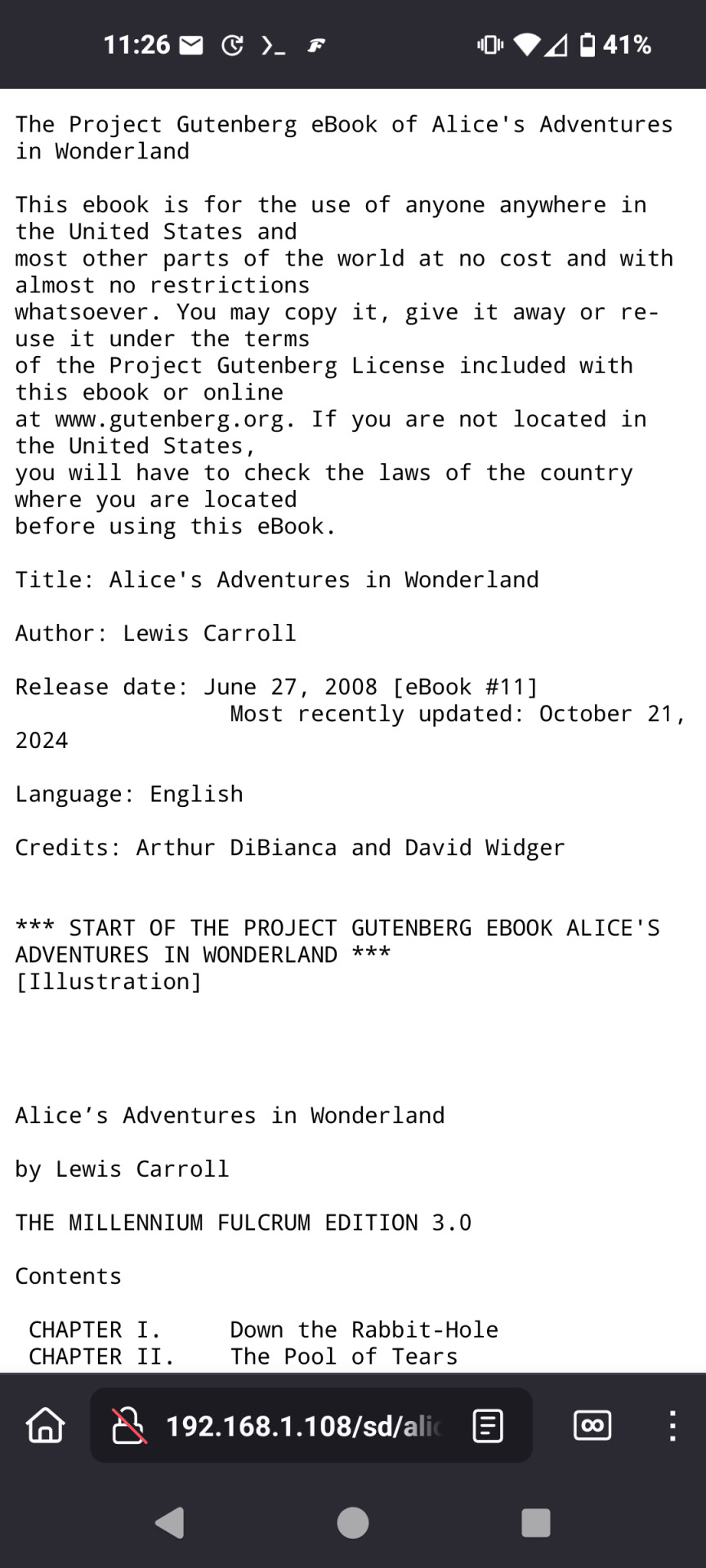
Im using a directory listing compiled using Pythons built in http server which I run and wget off the build machine before putting it on the micro sd to give a simple interface for browsing without too much screwing around.
Note: the text is split into 5kB pieces in the image which is no longer necessary
36 notes
·
View notes
Text
Python Libraries to Learn Before Tackling Data Analysis
To tackle data analysis effectively in Python, it's crucial to become familiar with several libraries that streamline the process of data manipulation, exploration, and visualization. Here's a breakdown of the essential libraries:
1. NumPy
- Purpose: Numerical computing.
- Why Learn It: NumPy provides support for large multi-dimensional arrays and matrices, along with a collection of mathematical functions to operate on these arrays efficiently.
- Key Features:
- Fast array processing.
- Mathematical operations on arrays (e.g., sum, mean, standard deviation).
- Linear algebra operations.
2. Pandas
- Purpose: Data manipulation and analysis.
- Why Learn It: Pandas offers data structures like DataFrames, making it easier to handle and analyze structured data.
- Key Features:
- Reading/writing data from CSV, Excel, SQL databases, and more.
- Handling missing data.
- Powerful group-by operations.
- Data filtering and transformation.
3. Matplotlib
- Purpose: Data visualization.
- Why Learn It: Matplotlib is one of the most widely used plotting libraries in Python, allowing for a wide range of static, animated, and interactive plots.
- Key Features:
- Line plots, bar charts, histograms, scatter plots.
- Customizable charts (labels, colors, legends).
- Integration with Pandas for quick plotting.
4. Seaborn
- Purpose: Statistical data visualization.
- Why Learn It: Built on top of Matplotlib, Seaborn simplifies the creation of attractive and informative statistical graphics.
- Key Features:
- High-level interface for drawing attractive statistical graphics.
- Easier to use for complex visualizations like heatmaps, pair plots, etc.
- Visualizations based on categorical data.
5. SciPy
- Purpose: Scientific and technical computing.
- Why Learn It: SciPy builds on NumPy and provides additional functionality for complex mathematical operations and scientific computing.
- Key Features:
- Optimized algorithms for numerical integration, optimization, and more.
- Statistics, signal processing, and linear algebra modules.
6. Scikit-learn
- Purpose: Machine learning and statistical modeling.
- Why Learn It: Scikit-learn provides simple and efficient tools for data mining, analysis, and machine learning.
- Key Features:
- Classification, regression, and clustering algorithms.
- Dimensionality reduction, model selection, and preprocessing utilities.
7. Statsmodels
- Purpose: Statistical analysis.
- Why Learn It: Statsmodels allows users to explore data, estimate statistical models, and perform tests.
- Key Features:
- Linear regression, logistic regression, time series analysis.
- Statistical tests and models for descriptive statistics.
8. Plotly
- Purpose: Interactive data visualization.
- Why Learn It: Plotly allows for the creation of interactive and web-based visualizations, making it ideal for dashboards and presentations.
- Key Features:
- Interactive plots like scatter, line, bar, and 3D plots.
- Easy integration with web frameworks.
- Dashboards and web applications with Dash.
9. TensorFlow/PyTorch (Optional)
- Purpose: Machine learning and deep learning.
- Why Learn It: If your data analysis involves machine learning, these libraries will help in building, training, and deploying deep learning models.
- Key Features:
- Tensor processing and automatic differentiation.
- Building neural networks.
10. Dask (Optional)
- Purpose: Parallel computing for data analysis.
- Why Learn It: Dask enables scalable data manipulation by parallelizing Pandas operations, making it ideal for big datasets.
- Key Features:
- Works with NumPy, Pandas, and Scikit-learn.
- Handles large data and parallel computations easily.
Focusing on NumPy, Pandas, Matplotlib, and Seaborn will set a strong foundation for basic data analysis.
9 notes
·
View notes
Text
Automate Simple Tasks Using Python: A Beginner’s Guide
In today's fast paced digital world, time is money. Whether you're a student, a professional, or a small business owner, repetitive tasks can eat up a large portion of your day. The good news? Many of these routine jobs can be automated, saving you time, effort, and even reducing the chance of human error.
Enter Python a powerful, beginner-friendly programming language that's perfect for task automation. With its clean syntax and massive ecosystem of libraries, Python empowers users to automate just about anything from renaming files and sending emails to scraping websites and organizing data.
If you're new to programming or looking for ways to boost your productivity, this guide will walk you through how to automate simple tasks using Python.
🌟 Why Choose Python for Automation?
Before we dive into practical applications, let’s understand why Python is such a popular choice for automation:
Easy to learn: Python has simple, readable syntax, making it ideal for beginners.
Wide range of libraries: Python has a rich ecosystem of libraries tailored for different tasks like file handling, web scraping, emailing, and more.
Platform-independent: Python works across Windows, Mac, and Linux.
Strong community support: From Stack Overflow to GitHub, you’ll never be short on help.
Now, let’s explore real-world examples of how you can use Python to automate everyday tasks.
🗂 1. Automating File and Folder Management
Organizing files manually can be tiresome, especially when dealing with large amounts of data. Python’s built-in os and shutil modules allow you to automate file operations like:
Renaming files in bulk
Moving files based on type or date
Deleting unwanted files
Example: Rename multiple files in a folder
import os folder_path = 'C:/Users/YourName/Documents/Reports' for count, filename in enumerate(os.listdir(folder_path)): dst = f"report_{str(count)}.pdf" src = os.path.join(folder_path, filename) dst = os.path.join(folder_path, dst) os.rename(src, dst)
This script renames every file in the folder with a sequential number.
📧 2. Sending Emails Automatically
Python can be used to send emails with the smtplib and email libraries. Whether it’s sending reminders, reports, or newsletters, automating this process can save you significant time.
Example: Sending a basic email
import smtplib from email.message import EmailMessage msg = EmailMessage() msg.set_content("Hello, this is an automated email from Python!") msg['Subject'] = 'Automation Test' msg['From'] = '[email protected]' msg['To'] = '[email protected]' with smtplib.SMTP_SSL('smtp.gmail.com', 465) as smtp: smtp.login('[email protected]', 'yourpassword') smtp.send_message(msg)
⚠️ Note: Always secure your credentials when writing scripts consider using environment variables or secret managers.
🌐 3. Web Scraping for Data Collection
Want to extract information from websites without copying and pasting manually? Python’s requests and BeautifulSoup libraries let you scrape content from web pages with ease.
Example: Scraping news headlines
import requests from bs4 import BeautifulSoup url = 'https://www.bbc.com/news' response = requests.get(url) soup = BeautifulSoup(response.text, 'html.parser') for headline in soup.find_all('h3'): print(headline.text)
This basic script extracts and prints the headlines from BBC News.
📅 4. Automating Excel Tasks
If you work with Excel sheets, you’ll love openpyxl and pandas two powerful libraries that allow you to automate:
Creating spreadsheets
Sorting data
Applying formulas
Generating reports
Example: Reading and filtering Excel data
import pandas as pd df = pd.read_excel('sales_data.xlsx') high_sales = df[df['Revenue'] > 10000] print(high_sales)
This script filters sales records with revenue above 10,000.
💻 5. Scheduling Tasks
You can schedule scripts to run at specific times using Python’s schedule or APScheduler libraries. This is great for automating daily reports, reminders, or file backups.
Example: Run a function every day at 9 AM
import schedule import time def job(): print("Running scheduled task...") schedule.every().day.at("09:00").do(job) while True: schedule.run_pending() time.sleep(1)
This loop checks every second if it’s time to run the task.
🧹 6. Cleaning and Formatting Data
Cleaning data manually in Excel or Google Sheets is time-consuming. Python’s pandas makes it easy to:
Remove duplicates
Fix formatting
Convert data types
Handle missing values
Example: Clean a dataset
df = pd.read_csv('data.csv') df.drop_duplicates(inplace=True) df['Name'] = df['Name'].str.title() df.fillna(0, inplace=True) df.to_csv('cleaned_data.csv', index=False)
💬 7. Automating WhatsApp Messages (for fun or alerts)
Yes, you can even send WhatsApp messages using Python! Libraries like pywhatkit make this possible.
Example: Send a WhatsApp message
import pywhatkit pywhatkit.sendwhatmsg("+911234567890", "Hello from Python!", 15, 0)
This sends a message at 3:00 PM. It’s great for sending alerts or reminders.
🛒 8. Automating E-Commerce Price Tracking
You can use web scraping and conditionals to track price changes of products on sites like Amazon or Flipkart.
Example: Track a product’s price
url = "https://www.amazon.in/dp/B09XYZ123" headers = {"User-Agent": "Mozilla/5.0"} page = requests.get(url, headers=headers) soup = BeautifulSoup(page.content, 'html.parser') price = soup.find('span', {'class': 'a-price-whole'}).text print(f"The current price is ₹{price}")
With a few tweaks, you can send yourself alerts when prices drop.
📚 Final Thoughts
Automation is no longer a luxury it’s a necessity. With Python, you don’t need to be a coding expert to start simplifying your life. From managing files and scraping websites to sending e-mails and scheduling tasks, the possibilities are vast.
As a beginner, start small. Pick one repetitive task and try automating it. With every script you write, your confidence and productivity will grow.
Conclusion
If you're serious about mastering automation with Python, Zoople Technologies offers comprehensive, beginner-friendly Python course in Kerala. Our hands-on training approach ensures you learn by doing with real-world projects that prepare you for today’s tech-driven careers.
2 notes
·
View notes
Text
Python Programming Language: A Comprehensive Guide
Python is one of the maximum widely used and hastily growing programming languages within the world. Known for its simplicity, versatility, and great ecosystem, Python has become the cross-to desire for beginners, professionals, and organizations across industries.
What is Python used for

🐍 What is Python?
Python is a excessive-stage, interpreted, fashionable-purpose programming language. The language emphasizes clarity, concise syntax, and code simplicity, making it an excellent device for the whole lot from web development to synthetic intelligence.
Its syntax is designed to be readable and easy, regularly described as being near the English language. This ease of information has led Python to be adopted no longer simplest through programmers but also by way of scientists, mathematicians, and analysts who may not have a formal heritage in software engineering.
📜 Brief History of Python
Late Nineteen Eighties: Guido van Rossum starts work on Python as a hobby task.
1991: Python zero.9.0 is released, presenting classes, functions, and exception managing.
2000: Python 2.Zero is launched, introducing capabilities like list comprehensions and rubbish collection.
2008: Python 3.Zero is launched with considerable upgrades but breaks backward compatibility.
2024: Python three.12 is the modern day strong model, enhancing performance and typing support.
⭐ Key Features of Python
Easy to Learn and Use:
Python's syntax is simple and similar to English, making it a high-quality first programming language.
Interpreted Language:
Python isn't always compiled into device code; it's far done line by using line the usage of an interpreter, which makes debugging less complicated.
Cross-Platform:
Python code runs on Windows, macOS, Linux, and even cell devices and embedded structures.
Dynamic Typing:
Variables don’t require explicit type declarations; types are decided at runtime.
Object-Oriented and Functional:
Python helps each item-orientated programming (OOP) and practical programming paradigms.
Extensive Standard Library:
Python includes a rich set of built-in modules for string operations, report I/O, databases, networking, and more.
Huge Ecosystem of Libraries:
From data technological know-how to net development, Python's atmosphere consists of thousands of programs like NumPy, pandas, TensorFlow, Flask, Django, and many greater.
📌 Basic Python Syntax
Here's an instance of a easy Python program:
python
Copy
Edit
def greet(call):
print(f"Hello, call!")
greet("Alice")
Output:
Copy
Edit
Hello, Alice!
Key Syntax Elements:
Indentation is used to define blocks (no curly braces like in different languages).
Variables are declared via task: x = 5
Comments use #:
# This is a remark
Print Function:
print("Hello")
📊 Python Data Types
Python has several built-in data kinds:
Numeric: int, go with the flow, complicated
Text: str
Boolean: bool (True, False)
Sequence: listing, tuple, range
Mapping: dict
Set Types: set, frozenset
Example:
python
Copy
Edit
age = 25 # int
name = "John" # str
top = 5.Nine # drift
is_student = True # bool
colors = ["red", "green", "blue"] # listing
🔁 Control Structures
Conditional Statements:
python
Copy
Edit
if age > 18:
print("Adult")
elif age == 18:
print("Just became an person")
else:
print("Minor")
Loops:
python
Copy
Edit
for color in hues:
print(coloration)
while age < 30:
age += 1
🔧 Functions and Modules
Defining a Function:
python
Copy
Edit
def upload(a, b):
return a + b
Importing a Module:
python
Copy
Edit
import math
print(math.Sqrt(sixteen)) # Output: four.0
🗂️ Object-Oriented Programming (OOP)
Python supports OOP functions such as lessons, inheritance, and encapsulation.
Python
Copy
Edit
elegance Animal:
def __init__(self, call):
self.Call = name
def communicate(self):
print(f"self.Call makes a valid")
dog = Animal("Dog")
dog.Speak() # Output: Dog makes a legitimate
🧠 Applications of Python
Python is used in nearly each area of era:
1. Web Development
Frameworks like Django, Flask, and FastAPI make Python fantastic for building scalable web programs.
2. Data Science & Analytics
Libraries like pandas, NumPy, and Matplotlib permit for data manipulation, evaluation, and visualization.
Three. Machine Learning & AI
Python is the dominant language for AI, way to TensorFlow, PyTorch, scikit-research, and Keras.
4. Automation & Scripting
Python is extensively used for automating tasks like file managing, device tracking, and data scraping.
Five. Game Development
Frameworks like Pygame allow builders to build simple 2D games.
6. Desktop Applications
With libraries like Tkinter and PyQt, Python may be used to create cross-platform computing device apps.
7. Cybersecurity
Python is often used to write security equipment, penetration trying out scripts, and make the most development.
📚 Popular Python Libraries
NumPy: Numerical computing
pandas: Data analysis
Matplotlib / Seaborn: Visualization
scikit-study: Machine mastering
BeautifulSoup / Scrapy: Web scraping
Flask / Django: Web frameworks
OpenCV: Image processing
PyTorch / TensorFlow: Deep mastering
SQLAlchemy: Database ORM
💻 Python Tools and IDEs
Popular environments and tools for writing Python code encompass:
PyCharm: Full-featured Python IDE.
VS Code: Lightweight and extensible editor.
Jupyter Notebook: Interactive environment for statistics technological know-how and studies.
IDLE: Python’s default editor.
🔐 Strengths of Python
Easy to study and write
Large community and wealthy documentation
Extensive 0.33-birthday celebration libraries
Strong support for clinical computing and AI
Cross-platform compatibility
⚠️ Limitations of Python
Slower than compiled languages like C/C++
Not perfect for mobile app improvement
High memory usage in massive-scale packages
GIL (Global Interpreter Lock) restricts genuine multithreading in CPython
🧭 Learning Path for Python Beginners
Learn variables, facts types, and control glide.
Practice features and loops.
Understand modules and report coping with.
Explore OOP concepts.
Work on small initiatives (e.G., calculator, to-do app).
Dive into unique areas like statistics technological know-how, automation, or web development.
#What is Python used for#college students learn python#online course python#offline python course institute#python jobs in information technology
2 notes
·
View notes
Text
Binance clone script — Overview by BlockchainX
A Binance Clone Script is a pre-built, customizable software solution that replicates Binance's features, connect with BlockchainX
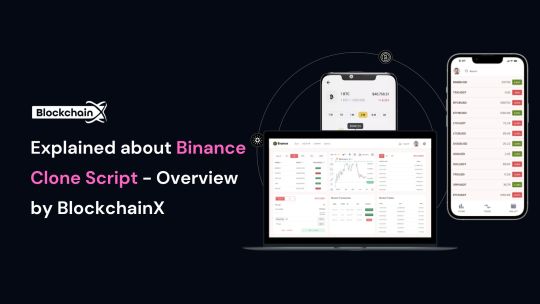
What is Binance Clone Script
A Binance clone script refers to the ready-made solution of the Binance platform that deals with core functions parallel to the widely acclaimed cryptocurrency exchange platform associated with Binance. It enables companies to establish their own platforms like Binance, perfectly parameterized in terms of functionality and user interface of world-famous exchanges. The clone script provides display flexibility with built-in functionality such as spot trading software, futures trading configurations, and wallet systems that are extremely secure.
Basically, it reduces development costs and latency because things like these are already built. And as this is a startup for many young entrepreneurs, they can have saved on their capital to expand or grow their business.
The script is blessed as its feature set caters to future demands in the field. One can enjoy a safe trading experience to customers while ensuring that every peculiarity of Binance’s success opens up to investors of the script.
How does the Binance clone script work?
The Binance clone script works to provide a ready-made platform that replicates Binance’s core features, such as user registration, wallet management, trade and enables users to create accounts, deposit or withdraw cryptocurrency, and trade digital assets through an interface easily and safely. The platform supports various trading methods such as market orders, limit orders and forward trading. It has built-in security features like two-factor authentication (2FA) to save the user money. Admin dashboards allow platform owners to manage users, manage tasks, and set up billing. The script can be tailored to your brand, connecting liquidity sources to make trading more efficient. In short, the Binance clone script provides everything needed to create a fully functional crypto exchange.
key features of a Binance Clone Script
The key features of a Binance Clone Script are designed to make your cryptocurrency exchange platform secure, user-friendly, and fully functional. Here’s a simple overview of these features:
User-Friendly Interface
Multi-Currency Support
Advanced Trading Engine
Secure Wallet System
KYC/AML Integration
Admin Dashboard
Security Features
Trading Options
These features help ensure that your Binance-like exchange is efficient, secure, and ready for the growing crypto market.
Technology Stack Used by BlockchainX
Technology stack used for developing the Binance clone script involves the most advanced technology combination that ensures that the platform must have so much security, scalability, and performance to make it a platform that is secure, scalable, and high-performance as well. Here are a few key technologies and their brief descriptions:
Blockchain Technology:
The underlying part of the cryptocurrency exchange is Blockchain because it ensures the safe and decentralized processing of transactions.
Normally executed on either Ethereum or BSC (Binance Smart Chain) to carry out smart contracts and token transfers.
Programming Languages:
Frontend: For frontend, React or Angular could be engaged in actualization of the user interface leading to a responsive and interactive experience on the various devices.
Backend: In backend, languages like Node.js, Python, or Ruby on Rails can be applied on how internal logic is being run by server and arbitration of user interaction with the module is foremost.
Databases:
These two databases, MySQL or Postgresql, are typically used in user information storage, transaction records, and other exchange information.
NoSQL such as MongoDB or other databases might be used for horizontal scalability and high-volume transaction storage.
Smart Contracts:
It is used to generate and send out smart contracts for auto-trading, token generation, and other decentralized functionalities.
Blockchain Wallets:
Fundamentally, this automatically links famous wallet systems such as MetaMask, Trust Wallet, or Ledger for the secure storage and transactions of cryptocurrency.
Advantages of using a Binance Clone Script
Here are the advantages of using a Binance Clone Script:
Faster Time-to-Market
Cost-Effective
Customizable Features
Liquidity Integration
Multiple Trading Options
So, when entering the marketplace of the cryptocurrencies it would be the most possible work of something to pay off at a rapid pace: the Binance Clone Script proves so.
How to Get Started with BlockchainX’s Binance Clone Script
It is quite a straightforward process to begin working with a BlockchainX Binance Clone Script-this involves the first step of getting in touch with the company for an initial consulting period to understand more about what you require, need, or customize for the site, and what your goals are. When BlockchainX has an understanding of your needs, they offer a detailed list of what a proposal would entail before they can start the work; afterward, they will estimate the costs needed to do the project. Once both sides accept both the presentations and all features and timelines are agreed with, BlockchainX starts working on the development process of building a Binance Clone Script tailored to the brand, user interface, and other features.
After the entire platform is created, it passes through severe testing to ensure that everything functions excellently. Deployment follows the thorough test. BlockchainX customizes your user interface and more extensions, after deployment. BlockchainX also commits to supporting and sustaining your exchange so that it runs successfully and securely.
Conclusion:
At the end, your confusion may as well be cut short. Yes, the Binance Clone Script will be a resilient solution to spark up the exchange platforms synthesizing user-generated cryptocurrency dreams in the blockchain, even without bankroll when it comes to developing the app. Turning with BlockchainX expertise, you can make an adjustment and scale a powerful platform stocked with the likes of Binance that produced Blockchains, while still containing some specific set-ups for your masterpiece. More amazing features are exclusive to the clone script, moreover, such as support for multiple currencies, high-end security, real-time data, and a smooth user interface that completes the trading process for your users without any glitch.
This solution gives easy access to ready-made solutions. It could have quality Depending on the time you conveniently let BlockchainX’s be and use both exchanges or any variation of the two permutations. After all, who decides to couple up with a one-experienced Crypto Exchange developer who is struggling to offer anything new.
#binance clone script#binance clone script development#binance clone script development service#blockchain technology#blockchain#cryptocurrency#cryptocurrencies
2 notes
·
View notes
Text
Infrastructure for Disaster Control, a.k.a. Automatic Builds
We all know the feeling of pure and utter stress when, ten minutes before the deadline, you finally click the Build And Export in your game engine and then it fails to build for some reason.
To prevent issues like this, people invented automated builds, also sometimes referred to as CI/CD.
This is a mechanism that tests the project every single time a change is made (a git commit is pushed, or a Perforce changelist is submitted). Because of this, we very quickly know whenever a change broke the build, which means we can fix it immediately, instead of having to fix it at the end.
It is also useful whenever a regression happens that doesn't break the build. We can go back to a previous build, and see if the issue is there or not. By checking a few builds by way of binary search, we can very quickly pinpoint the exact change that caused the regression. We have used this a few times, in fact. Once, the weaving machines stopped showing up in the build, and with this method, we were able to pinpoint the exact change that caused it, and then we submitted a fix!
It's very useful to have an archive of builds for every change we made to the project.
There are multiple different softwares that do this kind of thing, but Jenkins is by and far the most used. Both by indies, but also large AAA studios! So knowing how it works is very useful, so that's why I picked Jenkins for the job. Again, like with Perforce, it was pretty easy to install!
Here is a list of every build run that Jenkins did, including a neat little graph :)

Configuring it was quite tricky, though. I had to create a console terminal CLI command that makes Unreal Engine build project. Resources used: (one) (two)
It took many days of constant iteration, but in the end, I got it to work very well!
I also wrote some explanations of what Jenkins is and how to use it on the Jenkins pages themselves, for my teammates to read:
Dashboard (The Home Page):

Project Page:

Now, it is of course very useful to build the project and catch errors when they happen, but if no-one looks on the Jenkins page, then no-one will see the status! Even if the website is accessible to everyone, people won't really look there very often. Which kind of makes the whole thing useless… So to solve that issue, I implemented Discord pings! There is a Jenkins plugin that automatically sends messages to a specific Discord channel once the build is done. This lets everyone know when the build succeeded or failed.

We of course already had a discord server that we used to discuss everything in, and to hold out online meetings with. So this #build-status channel fit in perfectly, and it was super helpful in catching and solving issues.
Whenever a build failed, people could click on the link, and see the console output that Unreal Engine gave during the build, so we could instantly see where the issue was coming from. And because it rebuilds for every change that is made, we know for certain that the issue can only have come from the change that was just made! This meant that keeping every change small, made it easier to find and fix problems!
Whenever a build succeeds, it gets stored on the server, in the build archive.

But storing it on the server alone is nice and all, but people can't really do anything with them there. I could personally access them by remotely connecting to the server, but I cannot make my teammates go through all that. So I needed to make them more accessible for the whole team, to download whenever they please.
For this, I wanted to create a small website, from which they can download them. Just by going to the link, they could scroll through every build and download it immediately.
I already knew of multiple ways of easily doing this, so I tried out a few.
The Python programming language actually ships with a built-in webserver module that can be used very easily with a single command. But Python wasn't installed, and installing Python on Windows is kind of annoying, so I wanted something else. Something simpler.
I often use the program "darkhttpd" whenever I want a simple webserver, so I tried to download that, but I couldn't get it to work on Windows. Seems like it only really supports Linux…
So I went looking for other, single-executable, webserver programs that do support Windows.
And so I stumbled on "caddy". I'd actually heard of it before, but never used it, as I never had a need for it before then. For actual full websites, I've always used nginx. After some time of looking at the official documentation of caddy's various configuration file formats and command-line arguments, and tweaking things, I had it working like I wanted! It now even automatically starts when the computer boots up, which is something that Perforce and Jenkins set up automatically. Resources used: (one) (two) (three) (four)

And I think that's it! Unfortunately, none of this will roll over to the next team that has to work on this project, because none of this is code that is inside our project folder.
Here’s a summary of the setup, drawn as a network map:

Future
There is a concept called IAC, Infrastructure As Code, which I would like to look into, in the future. It seems very useful for these kinds of situations where other people have to be able to take over, and reproduce the setups.
4 notes
·
View notes
Text
Mathematical functions in Python ...

These are built-in functions or a part of the "math" modul.
Post #179: Python.Hub on Instagram, Mathematical built-in functions resp. methods in Python, 2024.
#i love coding#coding#programming#learning#education#programming language#i love programming#i love python#learn python#teaching#studying
10 notes
·
View notes
Text
Project Euler #2
Welcome back to my series on Project Euler problems. HackerRank Lets get into it.
Links:
Project Euler: https://projecteuler.net/problem=2 HackerRank: https://www.hackerrank.com/contests/projecteuler/challenges/euler002
Each new term in the Fibonacci sequence is generated by adding the previous two terms. By starting with 1 and 2, the first 10 terms will be: 1,2,3,5,8,13,21,34,55,89,… By considering the terms in the Fibonacci sequence whose values do not exceed N, find the sum of the even-valued terms.
So first thing to note is just how odds and evens work. This starts with 1 and 2 so Odd + Even = Odd, then the next term would just be Even + Odd = Odd. It isn't until the 3rd addition that we get Odd + Odd = Even. After that this cycle will repeat.
So really what this is asking for is, starting at index 2, what is the sum of every 3rd term less than N.
F(2) + F(5) + ... + F(3k + 2)
(Where F(N) is the Nth Fibonacci number)
Now, computing Fibonacci numbers notoriously sucks to do, with the naive way of doing it causing you to compute from just F(20) would require computing F(3) like hundreds if not thousands of times over. So the best way to do it is to create either a hash or a cache to store it. I'm going to be utilizing something built into Python, "lru_cache" from the "functools" module. It'll just store the answers for me so I don't have to recompute what F(10) is thousands of times.
Here's my HackerRank code:
import sys from functools import lru_cache @lru_cache def fibonacci(N: int) -> int: if N < 0: return 0 if N <= 1: return 1 return fibonacci(N-1) + fibonacci(N-2) t = int(input().strip()) for a0 in range(t): n = int(input().strip()) x = 2 f = fibonacci(x) total = 0 while f <= n: total += f x += 3 f = fibonacci(x) print(total)
So as you can see, I just start at 2 and keep incrementing by fibonacci number by 3 each time. Then the loop will stop when my fibonacci number exceeds N.
And that's all tests passed! Onto the next one!
2 notes
·
View notes
Text
"DCA"(DIPLOMA IN COMPUTER APPLICATION)
The best career beginning course....

Golden institute is ISO 9001-2015 certified institute. Here you can get all types of computer courses such as DCA, CFA , Python, Digital marketing, and Tally prime . Diploma in Computer Applications (DCA) is a 1 year "Diploma Course" in the field of Computer Applications which provides specialization in various fields such as Fundamentals & Office Productivity tools, Graphic Design & Multimedia, Programming and Functional application Software.

A few of the popular DCA study subjects are listed below
Basic internet concepts Computer Fundamentals Introduction to programming Programming in C RDBMS & Data Management Multimedia Corel draw Tally ERP 9.0 Photoshop
Benefits of Diploma in Computer Application (DCA)
After completion of the DCA course student will able to join any computer jobs with private and government sectors. The certification of this course is fully valid for any government and private deportment worldwide. DCA is the only best option for the student to learn computer skills with affordable fees.
DCA Computer course : Eligibilities are here... Students aspiring to pursue Diploma in Computer Applications (DCA) course must have completed their higher school/ 10 + 2 from a recognized board. Choosing Computers as their main or optional subject after class 10 will give students an additional edge over others. Apart from this no other eligibility criteria is set for aspirants. No minimum cutoff is required.

"TALLY"
A Tally is accounting software. To pursue Tally Course (Certificate and Diploma) you must have certain educational qualifications to thrive and prosper. The eligibility criteria for the tally course is given below along with all significant details on how to approach learning Tally, and how you can successfully complete the course. Generally, the duration of a Tally course is 6 month to 1 year ,but it varies depending on the tally institution you want to join. Likewise, tally course fees are Rs. 10000-20000 on average but it also varies depending on what type of tally course or college you opt for. accounting – Accounting plays a pivotal role in Tally
Key Benefits of the Course:
Effective lessons (topics are explained through a step-by-step process in a very simple language) The course offers videos and e-books (we have two options Video tutorials in Hindi2. e-book course material in English) It offers a planned curriculum (the entire tally online course is designed to meet the requirements of the industry.) After the completion of the course, they offer certificates to the learners.
Tally Course Syllabus – Subjects To Learn Accounting Payroll Taxation Billing Banking Inventory
Tally Course
Eligibility criteria: 10+2 in commerce stream Educational level: Certificate or Diploma Course fee: INR 2200-5000 Skills required: Accounting, Finance, Taxation, Interpersonal Skills Scope after the course: Accountant, Finance Manager, Chartered Accountant, Executive Assistant, Operations Manager Average salary: INR 5,00,000 – 10,00,000

"In this Python course"
Rapidly develop feature-rich applications using Python's built-in statements, functions, and collection types. Structure code with classes, modules, and packages that leverage object-oriented features. Create multiple data accessors to manage various data storage formats. Access additional features with library modules and packages.
Python for Web Development – Flask Flask is a popular Python API that allows experts to build web applications. Python 2.6 and higher variants must install Flask, and you can import Flask on any Python IDE from the Flask package. This section of the course will help you install Flask and learn how to use the Python Flask Framework.
Subjects covered in Python for Web development using Flask:
Introduction to Python Web Framework Flask Installing Flask Working on GET, POST, PUT, METHODS using the Python Flask Framework Working on Templates, render template function
Python course fees and duration
A Python course costs around ₹2200-5000.This course fees can vary depending on multiple factors. For example, a self-paced online course will cost you less than a live interactive online classroom session, and offline training sessions are usually expensive ones. This is mainly because of the trainers’ costs, lab assistance, and other facilities.
Some other factors that affect the cost of a Python course are its duration, course syllabus, number of practical sessions, institute reputation and location, trainers’ expertise, etc. What is the duration of a Python course? The duration of a basic Python course is generally between 3 month to 6 months, and advanced courses can be 1 year . However, some courses extend up to 1 year and more when they combine multiple other courses or include internship programs.
Advantages of Python Python is easy to learn and put into practice. … Functions are defined. … Python allows for quick coding. … Python is versatile. … Python understands compound data types. … Libraries in data science have Python interfaces. … Python is widely supported.

"GRAPHIC DESIGN"
Graphic design, in simple words, is a means that professional individuals use to communicate their ideas and messages. They make this communication possible through the means of visual media.
A graphic designing course helps aspiring individuals to become professional designers and create visual content for top institutions around the world. These courses are specialized to accommodate the needs and requirements of different people. The course is so popular that one does not even need to do a lot of research to choose their preferred colleges, institutes, or academies for their degrees, as they are almost mainstream now.
A graphic design course have objectives:
To train aspirants to become more creative with their visual approach. To train aspirants to be more efficient with the technical aspects of graphics-related tasks and also to acquaint them with relevant aspects of a computer. To train individuals about the various aspects of 2-D and 3-D graphics. To prepare aspirants to become fit for a professional graphic designing profession.
Which course is best for graphic design? Best graphic design courses after 12th - Graphic … Certificate Courses in Graphic Design: Adobe Photoshop. CorelDraw. InDesign. Illustrator. Sketchbook. Figma, etc.
It is possible to become an amateur Graphic Designer who is well on the road to becoming a professional Graphic Designer in about three months. In short, three months is what it will take to receive the professional training required to start building a set of competitive professional job materials.

THE BEST COMPUTER INSTITUTE GOLDEN EDUCATION,ROPNAGAR "PUNJAB"
The best mega DISCOUNT here for your best course in golden education institute in this year.
HURRY UP! GUYS TO JOIN US...
Don't miss the chance
You should go to our institute website
WWW.GOLDEN EDUCATION
CONTACT US: 98151-63600
VISIT IT:
#GOLDEN EDUCATION#INSTITUTE#COURSE#career#best courses#tallyprime#DCA#GRAPHICAL#python#ALL COURSE#ROOPAR
2 notes
·
View notes
Text
How do I learn Python in depth?
Improving Your Python Skills
Writing Python Programs Basics: Practice the basics solidly.
Syntax and Semantics: Make sure you are very strong in variables, data types, control flow, functions, and object-oriented programming.
Data Structures: Be able to work with lists, tuples, dictionaries, and sets, and know when to use which.
Modules and Packages: Study how to import and use built-in and third-party modules.
Advanced Concepts
Generators and Iterators: Know how to develop efficient iterators and generators for memory-efficient code.
Decorators: Learn how to dynamically alter functions using decorators.
Metaclasses: Understand how classes are created and can be customized.
Context Managers: Understand how contexts work with statements.
Project Practice
Personal Projects: You will work on projects that you want to, whether building a web application, data analysis tool, or a game.
Contributing to Open Source: Contribute to open-source projects in order to learn from senior developers. Get exposed to real-life code.
Online Challenges: Take part in coding challenges on HackerRank, LeetCode, or Project Euler.
Learn Various Libraries and Frameworks
Scientific Computing: NumPy, SciPy, Pandas
Data Visualization: Matplotlib, Seaborn
Machine Learning: Scikit-learn, TensorFlow, PyTorch
Web Development: Django, Flask
Data Analysis: Dask, Airflow
Read Pythonic Code
Open Source Projects: Study the source code of a few popular Python projects. Go through their best practices and idiomatic Python.
Books and Tutorials: Read all the code examples in books and tutorials on Python.
Conferences and Workshops
Attend conferences and workshops that will help you further your skills in Python. PyCon is an annual Python conference that includes talks, workshops, and even networking opportunities. Local meetups will let you connect with other Python developers in your area.
Learn Continuously
Follow Blogs and Podcasts: Keep reading blogs and listening to podcasts that will keep you updated with the latest trends and developments taking place within the Python community.
Online Courses: Advanced understanding in Python can be acquired by taking online courses on the subject.
Try It Yourself: Trying new techniques and libraries expands one's knowledge.
Other Recommendations
Readable-Clean Code: For code writing, it's essential to follow the style guide in Python, PEP
Naming your variables and functions as close to their utilization as possible is also recommended.
Test Your Code: Unit tests will help in establishing the correctness of your code.
Coding with Others: Doing pair programming and code reviews would provide you with experience from other coders.
You are not Afraid to Ask for Help: Never hesitate to ask for help when things are beyond your hand-on areas, be it online communities or mentors.
These steps, along with consistent practice, will help you become proficient in Python development and open a wide range of possibilities in your career.
2 notes
·
View notes
Text
Exploring Python: Features and Where It's Used
Python is a versatile programming language that has gained significant popularity in recent times. It's known for its ease of use, readability, and adaptability, making it an excellent choice for both newcomers and experienced programmers. In this article, we'll delve into the specifics of what Python is and explore its various applications.
What is Python?
Python is an interpreted programming language that is high-level and serves multiple purposes. Created by Guido van Rossum and released in 1991, Python is designed to prioritize code readability and simplicity, with a clean and minimalistic syntax. It places emphasis on using proper indentation and whitespace, making it more convenient for programmers to write and comprehend code.
Key Traits of Python :
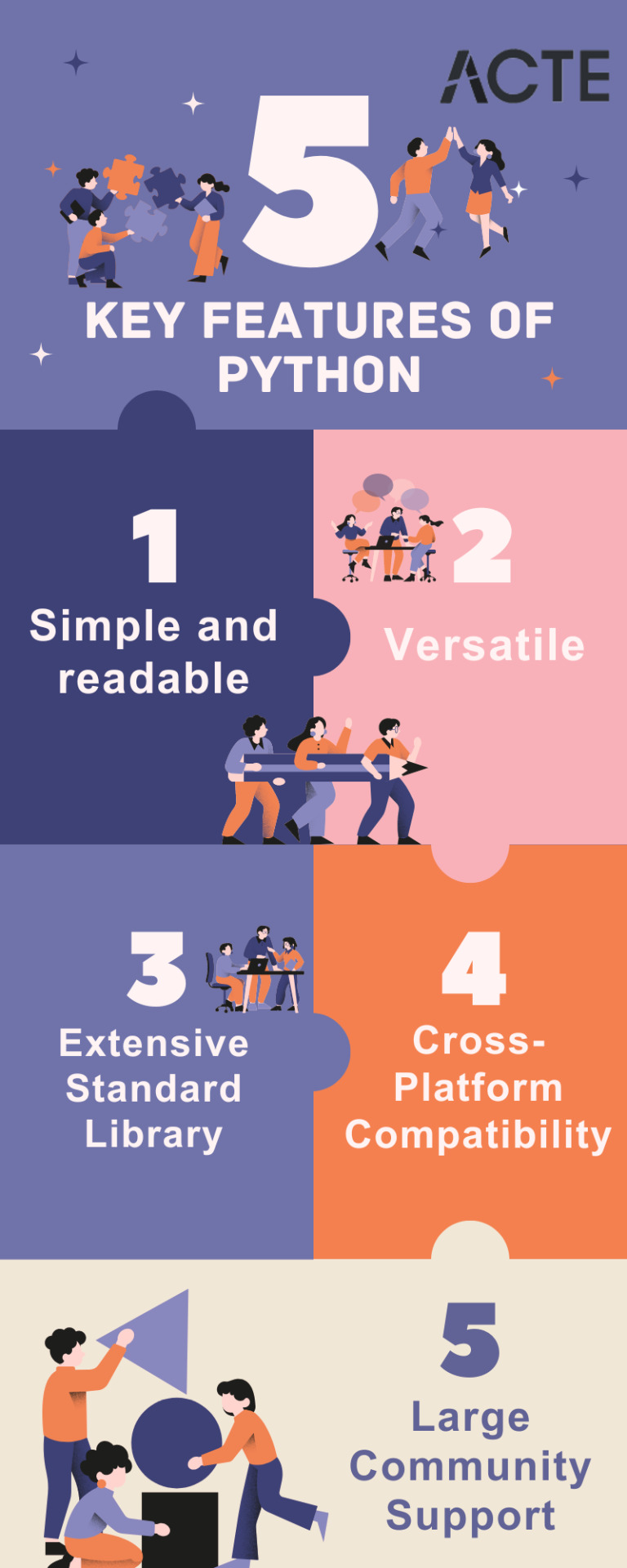
Simplicity and Readability: Python code is structured in a way that's easy to read and understand. This reduces the time and effort required for both creating and maintaining software.
Python code example: print("Hello, World!")
Versatility: Python is applicable across various domains, from web development and scientific computing to data analysis, artificial intelligence, and more.
Python code example: import numpy as np
Extensive Standard Library: Python offers an extensive collection of pre-built libraries and modules. These resources provide developers with ready-made tools and functions to tackle complex tasks efficiently.
Python code example: import matplotlib.pyplot as plt
Compatibility Across Platforms: Python is available on multiple operating systems, including Windows, macOS, and Linux. This allows programmers to create and run code seamlessly across different platforms.
Strong Community Support: Python boasts an active community of developers who contribute to its growth and provide support through online forums, documentation, and open-source contributions. This community support makes Python an excellent choice for developers seeking assistance or collaboration.
Where is Python Utilized?
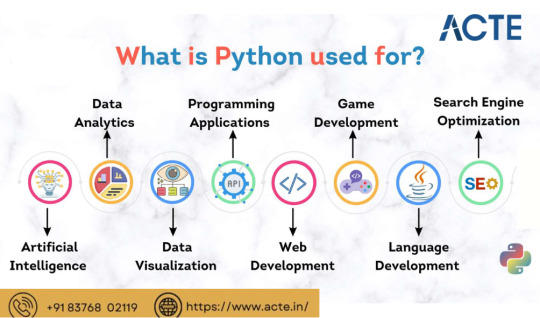
Due to its versatility, Python is utilized in various domains and industries. Some key areas where Python is widely applied include:
Web Development: Python is highly suitable for web development tasks. It offers powerful frameworks like Django and Flask, simplifying the process of building robust web applications. The simplicity and readability of Python code enable developers to create clean and maintainable web applications efficiently.
Data Science and Machine Learning: Python has become the go-to language for data scientists and machine learning practitioners. Its extensive libraries such as NumPy, Pandas, and SciPy, along with specialized libraries like TensorFlow and PyTorch, facilitate a seamless workflow for data analysis, modeling, and implementing machine learning algorithms.
Scientific Computing: Python is extensively used in scientific computing and research due to its rich scientific libraries and tools. Libraries like SciPy, Matplotlib, and NumPy enable efficient handling of scientific data, visualization, and numerical computations, making Python indispensable for scientists and researchers.
Automation and Scripting: Python's simplicity and versatility make it a preferred language for automating repetitive tasks and writing scripts. Its comprehensive standard library empowers developers to automate various processes within the operating system, network operations, and file manipulation, making it popular among system administrators and DevOps professionals.
Game Development: Python's ease of use and availability of libraries like Pygame make it an excellent choice for game development. Developers can create interactive and engaging games efficiently, and the language's simplicity allows for quick prototyping and development cycles.
Internet of Things (IoT): Python's lightweight nature and compatibility with microcontrollers make it suitable for developing applications for the Internet of Things. Libraries like Circuit Python enable developers to work with sensors, create interactive hardware projects, and connect devices to the internet.
Python's versatility and simplicity have made it one of the most widely used programming languages across diverse domains. Its clean syntax, extensive libraries, and cross-platform compatibility make it a powerful tool for developers. Whether for web development, data science, automation, or game development, Python proves to be an excellent choice for programmers seeking efficiency and user-friendliness. If you're considering learning a programming language or expanding your skills, Python is undoubtedly worth exploring.
9 notes
·
View notes
Text
Good afternoon TUMBLR - March 23th - 2024
''Mr. Plant has owed me a shoe since July 5, 1971."
January 1998 - October 1999 - NLNG - TSKJ Port Harcourt Project (Nigeria).
Part 3.
SWIMMING SUIT I hadn't brought a swimsuit from Italy, and since we spent Sunday in one of the hotel pools in the area, I decided to buy one. I told the driver to take me to a location where I could find one, he stopped the Land Rover in front of a small shop along Aba Road. There were different types and colors of swimsuits inside, in the end I opted for one in red and blue. Before the shopkeeper placed it in the usual supermarket plastic bag, I wanted to take one last look - and here's the ''surprise'': IT WAS 2nd HAND!! But the most incredible thing was that they had put it up for sale with ''clear signals'' of those who had used it before!!! I told the sales man: at least wash it? Naaa…… I left with a mixture of fury and disbelief: I couldn't belive to what my eyes have seen.
SOKU PROJECT SITE
Niger river - On the way to Soku.






As mentioned elsewhere, the Soku Gas Plant was a project that SAIPEM Nigeria was executing in parallel to our TSKJ project. The site was located about 2 hours by speed boat from Port Harcourt, in the middle of the Niger River Delta. All around there was a dense rainforest, so to avoid cutting down thousands of trees it was decided that the plant would be built on an artificial island in the middle of the river. A Spanish company specialized in dredging and construction of artificial islands (called reclaimed land) was commissioned and within 6 months a 1.5 km by 800 meter platform was ready to begin work. A camp was built by importing portacabins from SAIPEM NORWAY (yes, you read that right). The reasons behind SAIPEM Procurement was:
''If they are good for the cold of Norway, they will also be good for the tropical forest of Nigeria''. Carlo Sgorbani arrival to Port Harcourt. Sgorbani was also an ''old'' SAIPEM guy. I met him during the Bir Rebaa project in Algeria. I then found it again in Abu Dhabi for the Taweela aWater Project, where during the last part of the project he assumed the position of Site Manager (And immediately left our compound to rent a villa at Hilton hotel). An early one morning I went to Branch Office and met Sgorbani who was still under shock due the night flight from Paris.
Ohh...I cant believe to my eyes! How come you're here Carlo?
And he, with the perpetual cigarette in his hand: well… I should be the Site Manager of the Soku Gas Plant project…
Soku Gas Plant?? But… are you sure of what you say? I'm quite sure there are any Hilton villas in Soku….... well, come on… you can't always go for luxury… and then you'll see that the ex-Norway containers won't be so uncomfortable!
He didn't reply.
SAIPEM Club SAIPEM has always cared about the ''welfare'' of its employees located in the most sh****hole remote and difficult areas of the planet. Therefore the Management decided to install a clubhouse inside the Soku compound. As soon as the Worry project structure was made available, it was transported by barge to Soku. It consisted of different container modules, and inside it had a billiard room, ping pong, TV room, bar with tables where can play cards in the evening. Behind the bar counter, above the shelves that held the bottles of liquor, a long python skin had been fixed. And this will cause several problems.
PYTHON STRIKE The morning after the club inauguration, Sgorbani and all the other colleagues were woken up by strange moans and screams coming from inside the camp. They immediately rushed to the front of the club and found themselves in front of dozens of people lying on the ground crying, wriggling and sprinkling sand on their heads. Local people were screaming like:
Our Lord is dead…you killed our Lord our Lord is dead…you have killed our God....... All the expatriates present could not understand what was going on before their eyes. Sgorbani called the local PRO, who revealed the burden:
''Sir – he said – these people are telling that you from SAIPEM captured and killed their Lord, and then after having slaughtered him you hung his skin in your club, offending his memory even more – now they expect years of disgrace if nothing is done to remedy this tragedy."
But…but…All of this is inconceivable – replied Sgorbani – the python skin was hung on the wall of the bar when the structure was in Warry, months ago, not here……….
I know, Sir – said the PRO – but these people say that this was why they hadn't seen their Lord for months: he had migrated to Warry, someone from SAIPEM captured him and made him a trophy.
Sgorbani and all other expats know whether to laugh or get angry at what they had heard and what was happening in front of them - however the Site Manager understood that laughing at the matter could generate further and serious problems - so he asked the PRO:
Ok… okay… so what should we do?
Sir – said the PRO – I spoke with their Chief and he says that the only solution to this serious matter is to call a Great Medicine Man who lives in Calabar (about 200 km from Soku) Only he will be able to exorcise the bad influences caused to what SAIPEM people did. But first of all we need to remove the python skin off the bar wall, Sir.
Ok – replied Sgorbani – we'll do it right away, but in the meantime we have to get back to work!
No Sir, until everything is resolved, work cannot resume.
Sgorbani was about to fly into a rage, but was able to contain himself - he ordered the PRO to proceed as quickly as possible with the call of this ''medicine man'' - that he should come immediately, SAIPEM would spare no expense, and would do everything needed made available, starting from the speed boat. Two days of great tension passed in the camp and on the artificial island. Time seemed suspended, waiting for the arrival of the sorcerer who would resolve the drama. An eerie silence loomed over everything and everyone, when construction activities usually filled the place with noise. In just two days (a great achievement considering that it was happening in Nigeria) the ''Great Medicine Man of Calabar'' arrived in great pomp, dressed in traditional clothes, covered by a bright apple-green cloak, with a headdress of peacock feathers and studded with precious stones (nobody knew if true or fake…).

Between two wings of the crowd who knelt as he passed on the way from the docking pier to the club, the sorcerer distributed blessings with his inlaid staff. No one, except the faithful, was allowed inside the club, where, after a brief ceremony, the python skin was peeled off the wall and carefully carried outside by at least six weeping people. The skin was carried as if in procession to the pier, where a previously prepared canoe transported it across the river to the vicinity of the village where the local tribe lived. A pit had been dug there which, covered with a white sheet, welcomed the python's skin. Once the skin was wrapped, the burial proceeded, accompanied by songs, blessings and mysterious formulas recited by the Great Medicine Man, who every now and then drew water from a drum with a palm leaf and sprinkled the grave. Once filled with earth, flowers and tree branches were planted on the tomb, and the area was marked off with stones. The funeral was over, and the sorcerer moved on to collect the money from SAIPEM PRO - the cost of the entire "ceremony was over 20,000 dollars. The next day, work at site could finally resume.
ATTACK on SOKU COMPOUND Perhaps the python affair had been a sort of ''dress rehearsal'' to see the type of response that SAIPEM would have given to an emergency. The fact is that a few weeks passed, and a new big problem arose for Sgorbani and the SAIPEM expatriates on Soku project. It was an August hot morning, when they woke up with a noise caused by rifle and stick blows that an handful of ''rebels'' were giving to their dormitory containers who had come from Norway. After a few minutes, all the expatriates were gathered in front of the offices, and when asked by the one who seemed to be in charge "where the Chief was", the answer was that he was in his office. (Sgorbani used to get up very early). Some rebels entered the offices, and to make it clear that they had serious intentions, they fired a couple of rifle shots which fortunately did not hit Sgorbani, but lodged in the wall behind his head. He too was pushed into the square in front of the offices, and made to lie on his stomach like everyone else. The rebels claimed to have taken possession of the artificial island of SOKU and the site, to put an end to the indiscriminate exploitation of the River State's resources. They wanted money, hiring of local staff, salary increases for those already working with SAIPEM, construction of a school and a hospital in the adjacent community. These intentions would be followed by an ultimatum, after which if the requests were not accepted by the local governments and the top management of SAIPEM, they would begin to eliminate a hostage every 2 hours. While all this was happening, the Nigerian Army Security forces had surrounded the artificial island. A long-distance dialogue then began between the Major who led the military and the guy who professed to be the leader of the rebels. The military's strategy immediately appeared clear:
''First free the hostages and then we will sit down for negotiation'' - this was the message delivered to the attackers. Who naturally refused, demanding at least the delivery of a large sum of cash, the arrival of the local Governor, who should have handed himself over to them, to unblock the situation. In the meantime, time passed, and the time set for the expiry of the ultimatum approached, and the hostages were still on the ground with their hands behind their heads. The tension mounted as the hours passed, and when there were only a few minutes left before the ultimatum expired, suddenly the Security forces attacked the Rebels! Taken by surprise, many of them tried to escape, others took some of the hostages by force to shield themselves from the military fire. For a few minutes there was total chaos: shots, shouts, the rebels trying to reach some canoes hidden among the branches on the river bank, to escape capture. The clashes lasted a few minutes, and soon everything was silent, only a few sporadic bursts could be heard from the automatic weapons with which the Task Force eliminated the remaining resistance. Some rebels were captured and immediately knocked to the ground with rifle butts. Most of the hostages had fled to the dormitory containers and locked themselves inside. Once order was restored, the Major asked to speak to Sgorbani.
Do you have a couple of empty containers?
Yes, of course – replied the Site Manager
Have them taken to an open, sunny area. Zaccagnini had the order carried out, and after an hour the SAIPEM crane deposited two empty containers in an open area on the island. The Major then ordered his men to let the captured rebels enter the containers. When the operation was concluded, the containers were closed with heavy padlocks, and the Major set up guards. Then he said aloud:
''No one must go near the containers, this scum must remain awaiting the decisions of the Military Tribunal of Port Harcourt''.
6 notes
·
View notes
Text
More Notes on the Computer Music Playpen
I have finished maintenance on the VST3 plugin opcodes for Csound, Csound for Android, and some other things, and am re-focusing in composition.
One thing that happened as I was cleaning up the VST3 opcodes is that I discovered a very important thing. There are computer music programs that function as VST3 plugins and that significantly exceed the quality or power what Csound has so far done on it own, just for examples that I am using or plan to use:
The Valhalla reverbs by Sean Costello -- I think these actually derive from a reverb design that Sean did in the 1990s when he and I both were attending the Woof meetings at Columbia University. Sean's reverb design was ported first to Csound orchestra code, and then to C as a built-in opcode. It's the best and most widely used reverb in Csound, but it's not as good as the Valhalla reverbs, partly because the Valhalla reverbs can do a good job of preserving stereo.
Cardinal -- This is a fairly complete port of the VCV Rack "virtual Eurorack" patchable modular synthesiser not only to a VST3 plugin, but also to a WebAssembly module. This is exactly like sticking a very good Eurorack synthesizer right into Csound.
plugdata -- This is most of Pure Data, but with a slightly different and somewhat smoother user interface, as a VST3 plugin.
I also discovered that some popular digital audio workstations (DAWs), the workhorses of the popular music production industry, can embed algorithmic composition code written in a scripting language. For example, Reaper can host scripts written in Lua or Python, both of which are entirely capable of sophisticated algorithmic composition, and both of which have Csound APIs. And of course any of these DAWs can host Csound in the form of a Cabbage plugin.
All of this raises for me the question: What's the playpen? What's the most productive environment for me to compose in? Is it a DAW that now embeds my algorithms and my Csound instruments, or is it just code?
Right now the answer is not simply code, but specifically HTML5 code. And here is my experience and my reasons for not jumping to a DAW.
I don't want my pieces to break. I want my pieces to run in 20 years (assuming I am still around) just as they run today. Both HTML5 and Csound are "versionless" in the sense that they intend, and mostly succeed, in preserving complete backwards compatibility. There are Csound pieces from before 1990 that run just fine today -- that's over 33 years. But DAWs, so far, don't have such a good record in this department. I think many people find they have to keep porting older pieces to keep then running in newer software.
I'm always using a lot of resources, a lot of software, a lot of libraries. The HTML5 environment just makes this a great deal easier. Any piece of software that either is written in JavaScript or WebAssembly, or provides a JavaScript interface, can be used in a piece with a little but of JavaScript glue code. That includes Csound itself, my algorithmic composition software CsoundAC, the live coding system Strudel, and now Cardinal.
The Web browser itself contains a fantastic panoply of software, notably WebGL and WebAudio, so it's very easy to do visual music in the HTML5 environment.
2 notes
·
View notes
Text
The Best Programming Languages For Beginners

When choosing the right programming language, it’s essential to consider your goals and career. You want to make sure that you choose a programming language that is both in demand and easy to learn. Python is an ideal choice for beginners because it reads like English and has a simplified syntax. It’s also versatile and can be used for anything from web development to software development.
Python
Python is a popular general-purpose programming language that’s easy to learn for beginners and widely used in web development, machine learning, art, automation, and more. It also has a vast community of resources that are available to new programmers.
Java is another widely used programming language, especially for mobile app development. It’s used at companies of all sizes (including HubSpot!) and is one of the easiest to learn if you want to develop for a variety of platforms.Better is to click here or visit our official website to know about Programming question answer.
C is an older programming language but still a good choice for beginners because it’s more “machine-level” and gives you the lowest-level control over computer hardware. It’s also the most common base for other languages, like C# and Ruby.
Java
Despite being not as beginner-friendly as Python, Java is a good programming language to start with. It's a general-purpose programming language with a versatile library and free online tutorials.
It's also a cross-platform language, which makes it suitable for mobile and desktop applications. It's the language of choice for Android development and used in a number of enterprise-level software applications.
C is one of the oldest languages and forms the basis for modern languages like Python, Java, and JavaScript. However, it has a low level of abstraction and requires that code is compiled (translated into machine-readable code) before it can be run. This can make it difficult for beginners to understand. Moreover, its syntax can be confusing. But, it's an excellent foundation for more advanced language learning.
Many people are interested in learning programming, but choosing the best language can be intimidating. Luckily, there are plenty of resources to help you get started. You can learn the basics of multiple languages with a coding boot camp, such as the Georgia Tech Coding Boot Camp, which offers a variety of courses including HTML, JavaScript, and jQuery.
Other popular languages include C, which is a general-purpose, compiled language that’s widely used in back-end software applications like web servers. Python is a versatile programming language that’s easy to learn for beginners and can be used in any application. Ruby is a dynamic, object-oriented language that’s commonly implemented using the Rails framework. Its concise syntax and convention-over-configuration approach makes it easier to build and deploy apps.
Perl
Perl is a high-level dynamic general-purpose scripting language. It is popular among system administrators for its text-processing capabilities, specifically its own in-built version of regular expressions. It is also used for web development and GUI programming.
Beginners can start learning the basics of the programming language by following the free online courses offered on Udemy. These courses begin with basic theory and then move on to specific aspects of the language. They include topics such as lists, arrays, and subroutines. They also cover how to handle errors in coding. Perl has a large community of developers, with over 230 local groups, mailing lists and support/discussion websites. It is also open source and supports more than 25,000 extension modules on CPAN. This flexibility makes it an ideal programming language for beginners.
HTML
Computer programming allows us to create the software and applications that make our lives easier, more entertaining, and more efficient. But deciding which language to learn can be a difficult choice for beginners, particularly when there are so many options available.
youtube
Programming languages may seem different on the surface, but they all have similar structures and features. This means that whichever language you choose to learn, you’ll be learning important coding concepts that will be applicable to any other languages you might decide to explore later on.
Before deciding which programming language to learn, it’s important to consider your goals and current skill level. Once you’ve identified your goals, it’s easy to narrow down your options and find the best programming language for beginners.
2 notes
·
View notes
Text
How I Found the Best Data Science Certification That Actually Helped Me Learn
A few months ago, I was stuck in a very familiar place—scrolling through endless online courses, free YouTube playlists, and blog lists promising the “top 10 data science certifications.” Every title looked promising. Every syllabus seemed long enough to be impressive. And yet, none of them felt right.
I didn’t just want a certificate to add to my resume. I wanted to understand what I was learning. I wanted to build real skills, complete real projects, and actually feel like I could work in the data science field.
That’s when I realized most people (like me at the time) search for the best data science certification as if there’s a one-size-fits-all answer. But the truth is, “best” depends on what you’re looking for. Some want university brand names. Some want job placement. I personally wanted something in between: a course that was practical, affordable, and genuinely skill-focused.
After a lot of comparing, reviews, and trial-and-error, I came across a certification program that quietly ticked the boxes I had in mind. It wasn’t loud with marketing, but it had something others didn’t: simplicity, clarity, and a step-by-step path that made me feel like I was finally moving forward. That course was from Pickl.AI.
Here’s the link I bookmarked and eventually enrolled in: https://www.pickl.ai/course/data-science-certificate
The certification covered core data science tools—Python, Pandas, statistics, machine learning—but what I appreciated most was how each module built on the last. It wasn’t rushed. I could practice what I was learning, apply it to mini-projects, and slowly grow confident in working with real data.
Another highlight? The capstone project at the end. Instead of just clicking through video lessons and printing a certificate, I was challenged to build something that mimicked actual business data use cases. That made all the difference. It wasn’t just a "course I completed"—it became something I could actually show in interviews.
What also stood out was how the support team was reachable and helpful. When I got stuck in one of the machine learning modules, they pointed me to resources and even reviewed my code. It felt like I wasn’t learning alone, even though it was self-paced.
Today, after completing that certification, I’m not calling myself an expert—but I’m way more prepared. I’ve built projects I’m proud of, written about my work on LinkedIn, and even started applying for internships with confidence.
So if you're reading this and wondering where to start—don’t chase flashy names or huge price tags. Focus on what will actually teach you something meaningful and give you a space to practice and grow. For me, the Pickl.AI course did exactly that, and it might just be the right place for you to begin too.
0 notes